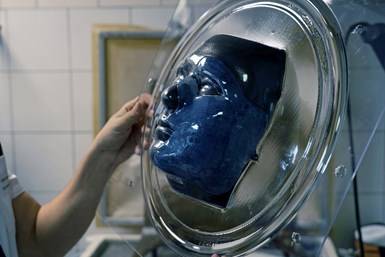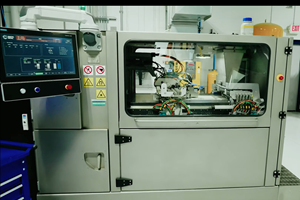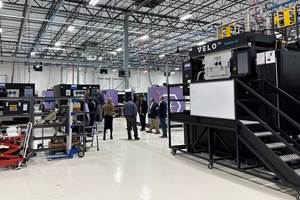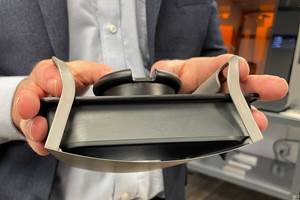Treating Children With Severe Burns Using Face Masks Produced With 3D Printing
Working with Formlabs, the Romans Ferrari Center developed a digital workflow for creating custom compressive masks for treating facial burns using 3D scanning and 3D printing — without having to touch the patient.
The reliefs are handcrafted on 3D printed molds out of silicone, which then serves as the positive for thermoforming the final mask out of a transparent plastic sheet. Photo Credit: Formlabs
Formlabs is helping facilitate a groundbreaking approach to burn treatment that uses 3D printing to reduce repeat trauma, as well as the risk of complications and scarring. The company is working with the Romans Ferrari Center, a pediatric rehabilitation facility near Lyons, France, that creates custom compressive masks for its patients.
This new process shows how 3D printing can streamline personalized health care, benefiting patients, especially children. Now the center can now quickly create compressive masks without having to touch the patient, which helps the patients heal and prevent scarring.
The traditional plaster casting process was a challenge, requiring children to sit still with warm bandages on their face, which can be a difficult experience. As the center primarily treats children and adolescent patients, Romans Ferrari sought a process that would enable them to create masks without having to touch the patient.
The center turned to 3D printing, selecting Formlabs’s Fuse 1 3D printers, which enabled a new approach that is more comfortable for patients. Instead of the plaster casting, the process is entirely digital, using a 3D scanner, CAD software and the Fuse 1 3D printer to create a relief to thermoform a final mask.
The center has vast experience providing treatment for severe facial burns, which includes specialized compressive masks that reduce the risk of complications and scarring. However, the traditional way to produce these masks involved an uncomfortable workflow that could induce posttraumatic stress disorder in children. Working with Formlabs, Romans Ferrari developed a digital workflow for creating custom compressive masks for treating facial burns using 3D scanning and 3D printing, thanks to a multiteam collaboration that included doctors, prosthetists and engineers.
Romans Ferrari accepts children and adolescents from across France who get referred to them by various hospitals after the initial (lifesaving, ICU) treatments. The first step is to treat the patient as soon as possible to prevent scarring complications such as scar contractures and hypertrophic scars. The goal is to epidermise the wounds as soon as possible so there are no more open wounds that may lead to infections, complications and fluid disbalance. Then, the actual rehabilitation starts, which includes dressing the skin with compressions and rehabilitation sessions that combine physiotherapy, filiform showers and other methods.
Compression devices help scars mature and heal, preventing complications, improving scar texture, making the skin more flexible, and guiding the body to develop the most comfortable and aesthetic scars possible as children grow. Beyond the traditional compressions used by burn centers worldwide, Romans Ferrari’s team also developed custom devices that include specialized reliefs — which the center calls growth and maturation devices (or DMDGs) — that enable a more targeted support at the scar level and a slightly finer way to work on the scar progression in terms of intrascar adhesion and elasticity.
Previously, for facial burns, compressive masks were made from plaster casts. The orthoprosthetist created a negative with plaster strips, from which they created a positive, which they used to thermoform the final mask. “It required the patients to be motionless for the duration of the plaster cast that lasts about half an hour, which can be difficult, especially for children, and could reactivate symptoms of post-traumatic stress disorder because the bandages are a little warm, and it is sometimes unpleasant for the patients to have the heat on their face,” says Sara Arias, Romans Ferrari physician for physical and medical rehabilitation.
To address that issue, the center looked at 3D printing. The new workflow involves scanning the patient’s face with a 3D scanner and using CAD software to design a mask based on the scan. Before scanning, the doctor gently marks the locations for the DMDG devices onto the face of the patient and the technician uses a digital pen to precisely add these engraved details to the design. The mask is then 3D printed on a Fuse 1 selective laser sintering (SLS) 3D printer and serves as the positive for thermoforming the final mask.
“[The new workflow] is faster and also more comfortable for the patient because they don’t feel the plaster strips on their face,” says Dr. Arias. “The results of 3D printing have always been satisfactory.”
Since center set up the new workflow a year ago, it has already exceeded a hundred masks. “We are able to produce compressive devices that we could not produce using conventional methods,” says Christophe Debat, Romans Ferrari general manager. “Our fitters have mastered the tool and the process, and are now producing these devices whenever they’re necessary.”
Romans Ferrari currently treats approximately 25% of severely burned children in France and has worked with clinics within France and in other countries such as Italy and Jordan. Thanks to the use of digital technologies, it has also become possible to provide treatment for patients who live far away from Lyon. Recently, Romans Ferrari collaborated with the organization Doctors Without Borders in Jordan, where doctors scanned the face of a patient and sent the scan file to the pediatric rehabilitation center. The team was then able to manufacture compressive devices in France and ship them to Jordan.
- Learn about Formlabs’ tough elastomer powder for strong, functional, skin-safe parts. The TPU 90A powder is the first elastomer material for Formlabs’ Fuse Series 3D printers and it enables durable, skin-safe parts at a low cost for a variety of industries, including health care, consumer goods, manufacturing and engineering.
- Read about Formlabs’ Dental LT Comfort Resin which is a flexible, durable material for comfortable long-term occlusal splints, nightguards and bleaching trays. BioMed Durable Resin is approved for human contact and it enables the creation of durable biocompatible and impact-resistant medical devices and instruments.
Related Content
8 Transformations 3D Printing Is Making Possible
Additive manufacturing changes every space it touches; progress can be tracked by looking for moments of transformation. Here are 8 places where 3D printing is enabling transformative change.
Read MoreFrom Polymer Tooling to Metal Production Via 3D Printing
As Azoth has adopted new additive manufacturing technologies, its work has transitioned from tooling to production parts for automotive, medical and defense.
Read MoreZeda AM Production Plant in Ohio Now Open — Thoughts on the New Facility
73,000-square-foot metal powder bed fusion plant includes extensive machining capability plus separate operational models for serving medical versus other businesses.
Read MoreFormlabs Part Removal Mechanism Enables Lights-Out Production
A build platform overcoming the need for manual part removal enables automated part handling, and therefore continuous production from one build cycle to the next.
Read MoreRead Next
GE Additive Rebrands as Colibrium Additive
As part of the brand name transition, both the Concept Laser and Arcam EBM legacy brands will be retired.
Read More3D Printing Brings Sustainability, Accessibility to Glass Manufacturing
Australian startup Maple Glass Printing has developed a process for extruding glass into artwork, lab implements and architectural elements. Along the way, the company has also found more efficient ways of recycling this material.
Read MoreLooking to Secure the Supply Chain for Castings? Don't Overlook 3D Printed Sand Cores and Molds
Concerns about casting lead times and costs have many OEMs looking to 3D print parts directly in metal. But don’t overlook the advantages of 3D printed sand cores and molds applied for conventional metal casting, says Humtown leader.
Read More













.png;maxWidth=300;quality=90)











